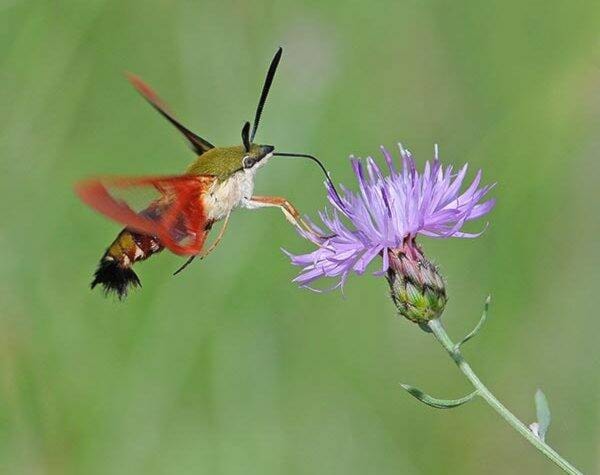A week ago, I saw my first hummingbird moth of this year. It was not one that I recognised, but it was hovering in front of a flower in broad daylight in my perennial border.
At first, I was puzzled because it was so small, a non-de-script beige colour with furry looking wings.
The hummingbird moths that I have seen here in the valley before are larger with very pretty, colourful markings and conspicuously clear wings.
They are called the Hummingbird Clearwing Moth or Hawkmoth (Hemaris thysbe). They are not common but when you see one you will be amazed and forgiven for thinking you are watching a very tiny hummingbird crossed with a bumble bee.
The adult moths feed during the day. To reach nectar at the bottom of deep tubular flowers they have a very long proboscis or tongue. When not in use the proboscis is curled up inside their mouth. As they probe for food in various flowers the proboscis may not unfurl completely and appear bent.
The wings are clear, narrow, and streamlined with a span of about 2 inches. As the moths hover in front of flowers to feed, the wings are a blur. They allow the moth to manoeuvre easily from side to side and even backwards just like a hummingbird. The constant motion helps to avoid predation.
Most hawkmoth adults are nocturnal, but the larvae (caterpillars) are not. The larvae of the clearwing look like honeysuckle and hawthorn leaves. The adult clearwings feed on many flowers, especially lilacs, beebalm, and thistles. I have seen them on phlox and sweet William flowers.
Around the same time, Eileen Bouvier called to tell me about the “huge” caterpillars (3-4 inches long) she had found.
One was black and had a red head and an upwardly pointed sharp red tail or horn. The other was darkish green also with a horn. My research indicates they were the larvae of the nocturnal Bedstraw Hawkmoth or Sphinx Moth. It is also a very pretty, large moth with a wingspan of 5-8 inches
When the caterpillars have horns, they are referred to as Hornworms. The fierce looking horns are there to deter predators, but do not harm humans.
Eileen put them back in her garden to let them pupate over the winter and emerge next spring.
